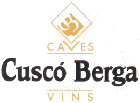Castel Sant Antoni
by
Kathy and Terry Sullivan
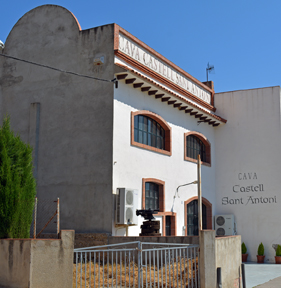 Summary: One might think that a small boutique winery close to a colossal giant winery would not survive. That is not the case for Castell Sant Antoni. Visitors get a different experience at Castell Sant Antoni located in the town of Sant Sadurní d’ Anoia, the capital of cava. Their success at crafting cava has led to plans to build a new winery facility in the future.
Summary: One might think that a small boutique winery close to a colossal giant winery would not survive. That is not the case for Castell Sant Antoni. Visitors get a different experience at Castell Sant Antoni located in the town of Sant Sadurní d’ Anoia, the capital of cava. Their success at crafting cava has led to plans to build a new winery facility in the future.
In the shadow of a giant, Castell Sant Antoni is easy to find in the town of Sant Sadurní d’ Anoia. A retail store is located on the corner of a street and further down the street is the winery, a bright white building bearing the name Cava Castell Sant Antoni. Outside the winery is an old wood wine press indicating a winery inside.
History
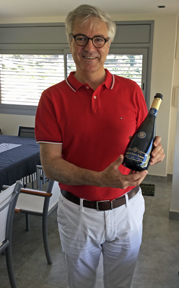 Pere Canals, owner, is enthusiastic about the cavas he is producing at Castell Sant Antoni. The family history of Castell Sant Antoni began in 1963 by Pere’s father-in-law who started making cava in his home. Outgrowing the space at home, a winery was located in town and soon was producing cava and wine. When Pere’s father-in-law retired, he asked Pere to take over the winery. Then in 1998 Pere left the winery and founded his own winery, Castell Sant Antoni, and moved into the current location. Pere began selling his wines in 1999.
Pere Canals, owner, is enthusiastic about the cavas he is producing at Castell Sant Antoni. The family history of Castell Sant Antoni began in 1963 by Pere’s father-in-law who started making cava in his home. Outgrowing the space at home, a winery was located in town and soon was producing cava and wine. When Pere’s father-in-law retired, he asked Pere to take over the winery. Then in 1998 Pere left the winery and founded his own winery, Castell Sant Antoni, and moved into the current location. Pere began selling his wines in 1999.
From the windows of the retail store and from the winery, visitors will notice the immense building a short distance away, one of the largest cava producers in Spain. When asked if this presented a challenge for wine tourism, Pere was quick to say that people visit that cava producer and then many will come to visit him to encounter a different experience.
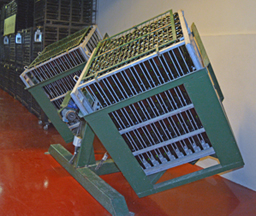 Winery
Winery
One of the first items to see upon entering the winery are two gyropalettes connected by a machine that automatically rotates them on a schedule. We were fortunate to see the machine turn just as we entered the room. Pere estimated that they turn slightly about every hour. These automated riddling machines are used to riddle the standard 750 ml bottles.
The personal touch is important for cava production at Castell Sant Antoni. Disgorging of 70,000 bottles is done by hand, and usually the bottle neck is not frozen beforehand. This takes skill and concentration not to lose the precious cava. The personal touch is also apparent in the family. Pere’s son Sergi Canals Canals is planning to receive a Master’s degree in enology at UC Davis. We met Sergi who already has plans to take the bodega into the future.
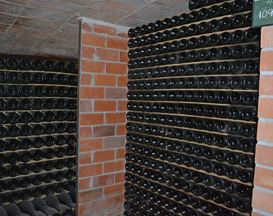 Below the ground level are the cellars that include numerous small rooms where cavas are stored. Each season’s cava production has its own area. Before long, Pere is planning to move the winery equipment to the first floor to free up space for more bottles of cava to age in the cellar.
Below the ground level are the cellars that include numerous small rooms where cavas are stored. Each season’s cava production has its own area. Before long, Pere is planning to move the winery equipment to the first floor to free up space for more bottles of cava to age in the cellar.
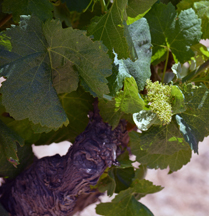 Vineyards
Vineyards
The vineyards are four kilometers away from the winery. Views of Montserrat Mountain are easily visible from the area. Several varietal grapes are planted including: Macabeo, Xarel.lo, Parellada, Chardonnay, Pinot Noir and Garnacha. The 17 hectares (42 acres) of Castell Sant Antoni vineyards are on the Penedès plain amidst a sea of vineyards. This is a prime location to grow indigenous cava grapes. It is here that the sun glistens on the bright green leaves. With such good growing conditions, the grape leaves grow prolifically and must be pruned to allow the sun to reach the grape clusters.
A small, white house close to the vineyards has been renovated and is available for wine tastings. The site of this tasting room in the vineyards is a wine tourist’s dream. It offers amazing views of the countryside and the vines are just steps away. The modern decor includes a single table where several people can enjoy a tasting and a sitting area where it is easy to relax and enjoy a bottle of cava. On a fine sunny day take advantage and walk outside with cava in hand to behold the horizon.
Castell Sant Antoni may not remain in the shadow of a giant forever. Future plans include adding a much larger winery facility near the vineyard tasting room. This will offer the winery more control and hands-on through the entire process from the vineyard to the sale at one location. Currently, the base wines for the cava are made at another winery. With the new facility, the base wines would be made onsite.
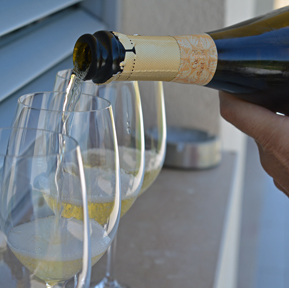 Cava
Cava
The Cava Gran Reserva Brut Nature Barrica is a blend of 35% Chardonnay that was aged in barrel and 65% a blend of the Macabeo, Xarel.lo, and Parellada. The yellow colored cava spent eight years aging. There were multiple beads of slowly moving bubbles forming a mousse on the surface. The cava offered apple, pear, freshly baked bread and a hint of caramel with a creamy texture and lively mouthfeel. It had a crisp apple finish.
The Brut Gran Reserva was a dark yellow color with beads of bubbles forming a mousse on the surface. The blend was Macabeo, Xarel.lo, Parellada and Chardonnay. The cava was aged for a minimum of seven years. The cava had apple and citrus on the aroma while the taste was reminiscent of apple, freshly baked bread, and pear. The finish was fruity with the fruit yielding to bread notes.
The Camí del Sot Brut Nature Reserva was a yellow colored blend of Macabeo, Xarel.lo and Parellada. There were beads of bubbles slowly rising to the surface forming a mousse. There was green apple on the aroma as well as the taste along with citrus, a hint of bread dough and a pleasant mouthfeel. Apple was predominant on the finish.
The 2003 Torre de L' Homenatge Brut Nature Gran Reserva was a blend of Macabeo, Xarel.lo and Parellada that was aged for at least 120 months. The cava was a dark yellow to gold color with a slow stream of bubbles rising to the surface. Orange blossoms and minerals were on the aroma. The taste offered orange blossoms, minerals, honey and had a lively mouthfeel. Orange dominated the finish and had a long aftertaste.
Wine Tourism
When planning to visit Castell Sant Antoni, call ahead for an appointment. Appointments may be made online or by phone.
Castell Sant Antoni
Passeig del Parc, 13
08770 Sant Sadurní d’ Anoia
Barcelona, Spain
Phone: +34 93 818 30 99
Article written June 2015
Please support the following.
 |
|||
 |
 |

